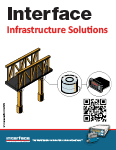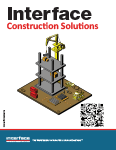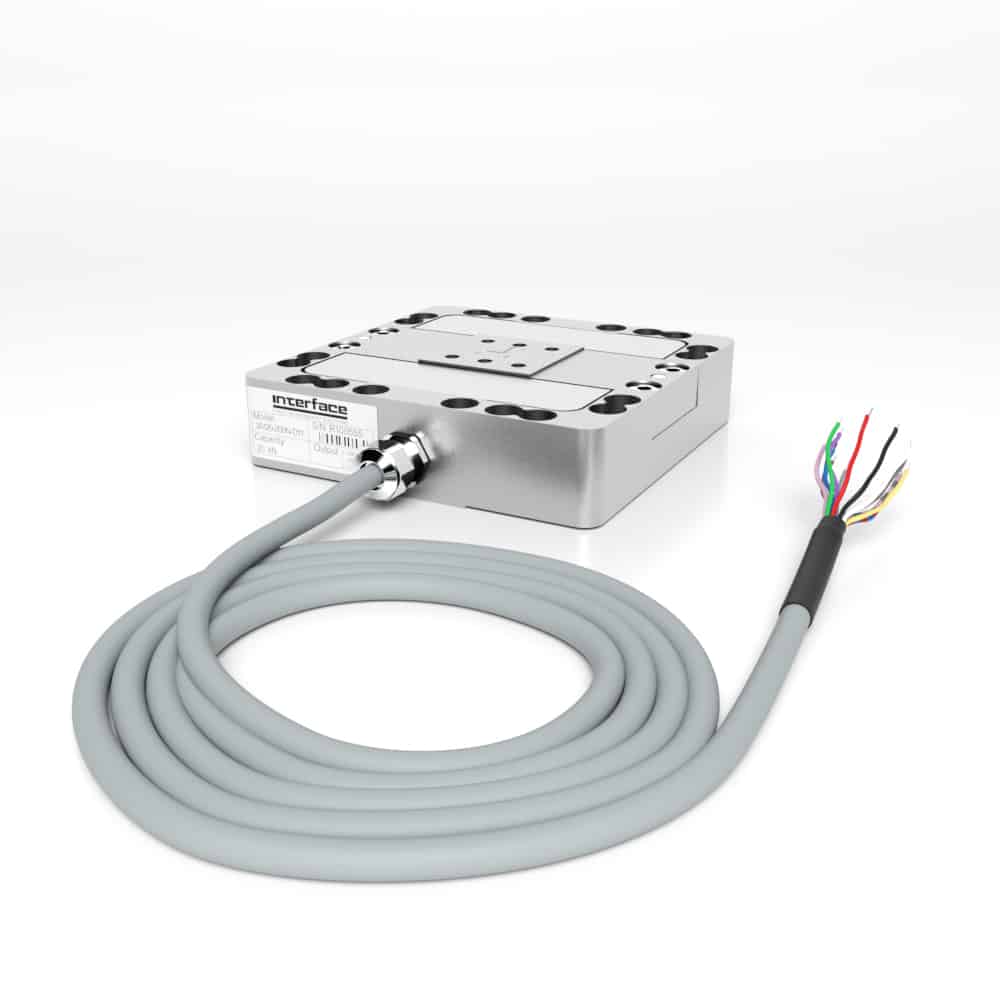Interface sensor technologies and solutions find extensive usage in the global construction sector for monitoring and controlling the loads encountered during the construction projects. From bridges and dams to high-rise buildings and tunnels, measurement devices and instrumentation are utilized by civil engineers, heavy equipment manufacturers, material engineers, and test labs to accurately measure and test weight, force, and torque across a variety of use cases.
The massive global construction industry, estimated to be nearly $13T in spending, is broad and diverse in use of measurement solutions. From single building tools to heavy machines used to move concrete slabs, measurement is fundamental in construction design and use for projects, tools and heavy equipment.
Interface products for test and measurement in this diverse industry are used in:
- Residential Construction
- Commercial Construction
- Infrastructure Construction
- Industrial Construction
- Civil Engineering Projects and Construction
- Mining and Tunneling
- Environmental Remediation
- Specialty Projects
- Heavy Equipment Manufacturing
- Transportation and Vehicle OEMs
- Cranes and Lifting Equipment
Interface load cells offer precise measurements of applied forces, furnishing essential data regarding the structural response under various load circumstances. This data plays a critical role in evaluating structural integrity, detecting potential vulnerabilities, and optimizing design to guarantee the safety and dependability of infrastructure.
Products we commonly supply to construction industry participants include:
- Load Cells
- Miniature Load Cells
- Torque Transducers
- Scales
- Multi-Axis Sensors
- Load Pins, Load Shackles and Tension Links
- Instrumentation
- Digital, Wireless and Bluetooth Solutions
- Custom Solutions
Load cells also are commonly used in construction equipment including cranes, hoists, and lifts. By incorporating Interface’s load cells into these machines, construction operators can reliably ascertain the loads being lifted or moved, ensuring compliance with secure operational thresholds.
By providing real-time load data, Interface’s load cells enable engineers and construction industry players to make informed decisions regarding the structural design, material selection, and load capacity of different machines and equipment. Torque transducers assist in evaluating and monitoring static and rotary movements of objects like motors and tools. Instrumentation is used to gather the data from measurements, which can influence design and be used as embedded technologies to give real-time feedback in use, just as in cranes and lifts.
Safety is of the utmost importance in the construction sector. Severe failures in equipment can be dangerous to machine operators, and protection and safety for users can be used through the use of force sensor technologies with Interface’s precision load cells, torque transducers, load pins, tension links and load shackles.
Applications of Force Measurement Products Used in the Construction Industry:
Bridge Construction: Load cells are employed in bridge construction to monitor the loads experienced by different components such as piers, beams, and cables. They help ensure that the bridge can handle the anticipated weight and forces and provide valuable data for load testing and structural analysis. Bridges also use sensors to provide ongoing monitoring of environmental changes, as noted in our case study Monitoring Seismic Force of a Suspension Bridge.
High-Rise Building Construction: For structural support, load cells are used during the construction of tall buildings to measure the loads exerted on structural elements like columns, slabs, and foundation systems. They assist in evaluating the structural integrity, optimizing design, and determining load distribution for safe and stable construction.
Crane and Heavy Lifting Operations: Sensors, including load cells, are frequently integrated into cranes, hoists, and lifting equipment to accurately measure the loads being lifted. This enables operators to ensure that the weight being lifted is within safe operating limits, preventing overloading and potential accidents.
Foundation Load Testing: Utilized in foundation load testing, load cells help to assess the bearing capacity and settlement behavior of foundations. They help determine the maximum loads that can be supported by the foundation, ensuring its stability and preventing settlement-related issues.
Structural Monitoring: Structural and civil engineers use load cells for ongoing monitoring of loads in structures such as tunnels, dams, and retaining walls. They provide continuous data on the loads acting on these structures, helping engineers assess their performance, detect any excessive stress or deformations, and ensure their long-term safety.
Material Testing: The materials used in construction range from steel to wood, even fabricated materials like rubber and foam. Load cells are employed in material testing laboratories to measure the strength and mechanical properties of construction materials such as concrete, steel, and timber. They play a critical role in conducting compression, tension, and bending tests, providing accurate load measurements for material performance evaluation.
Construction Equipment Calibration: As with all critical sensors, load cells are needed to calibrate and verify the accuracy of construction equipment, including weighing scales, hydraulic systems, and lifting devices. This ensures that the equipment operates correctly and delivers precise load measurements during construction activities. Utilizing Interface calibration grade load cells and systems is highly recommended for this type of use.
Construction Brochure



 Aerial Lift Overload Control
Aerial Lift Overload Control 










Building a Clean Energy Future in Hydrogen with Force
/in Blog /by Jamie GlassInterface is a supplier of force measurement solutions for clean energy providers and equipment makers. Brian Peters writes about the dynamics of applying force testing in hydrogen energy to the Winter Edition of Global Hydrogen Review. Learn how force measurement is used in research, production, storage and testing of hydrogen sources and equipment.
Year in Review of Top Interface Solutions and Applications
/in Blog /by Jamie GlassInterface is at the forefront of innovative use cases and applications, providing quality devices worldwide to gather precision measurements. Interface unveils the top industry solutions, product use cases and applications that define force measurement in 2023.
Top 10 Trends in Test and Measurement
/in Blog /by Jamie GlassInterface is privy to the evolving landscape of test and measurement based on product demands and applications. Trends show an increased need for mini load cells, customization, environmental solutions, material testing, multi-axis sensors, DAQ, wireless, and measurement data software. Learn more about the 2023 trends test and measurement based on incoming inquiries to our application engineers.
Enhancing Structural Testing with Multi-Axis Load Cells
/in Blog /by Jamie GlassInterface 2-axis, 3-axis, and 6-axis load cells are all excellent options for structural testing. Multi-axis load cells are essential tools for structural testing, providing valuable insights into the behavior of structures under various loading conditions. These multi-axis sensors measure forces in multiple directions, enabling engineers to identify potential weaknesses, assess structural integrity, and optimize designs.
Interface Column Load Cells
/in Blog /by Jamie GlassInterface column load cells handle higher axial (vertical) loads while maintaining accuracy and reliability. They are used for vertical force measurement applications, including high-capacity weighing, thrust measurement, and structural and material testing. Column load cells are rugged, providing a more durable solution for testing and calibration that has exposure to environmental conditions.
Fatigue Testing with Interface Load Cells
/in Blog /by Jamie GlassFatigue testing requires accurate and reliable force measurement. Interface fatigue-rated load cells are designed to withstand the rigors of repeated loading, which makes them ideal for even the most demanding high cycle count fatigue testing applications. Interface uses ‘fatigue-rated’ as an exact specification that defines a special class of load cell design and construction.
Monitoring and Controlling Spillway Lift Gates
/in Blog /by Jamie GlassInterface load cells are used in spillway gates to measure the force or load acting on the gate. Measuring accuracy is essential for managing water flow in spillways, dams, and similar water management structures. Civil engineers and equipment manufacturers need immediate data to modernize vital infrastructure worldwide. Retrofitting spillways with advanced sensor technologies is essential to maintain gates, improve lift and closure, protect the environment, and safeguard people.
Outlining Force Solutions for Structural Outrigging
/in Blog /by Jamie GlassInterface provides load cells and wireless technologies for structural outrigging. Force measurement sensor technologies provide high accuracy measurement of the outrigging equipment in test and actual use. The applications range from integrating sensors into outrigger equipment to using load cells for real-time monitoring of physical structures using outrigger supports. Interface load cells are used by outrigging engineers, civil engineers and heavy equipment manufacturers, oil and gas, construction industry and marine equipment companies.
Wireless Telemetry Systems 101
/in 101 Series, Blog /by Jamie GlassInterface offers a wide range of wireless telemetry products including load cells, transmitters, bases, communication modules and data acquisition systems. A wireless telemetry system enables the remote measurement and transmission of data from one location to another without the need for physical wired connections. Components in wireless telemetry systems typically include sensors, transducers, instrumentation, communication modules, transmitters, displays and printers. Learn more about Interface WTS products in our Wireless Telemetry Systems 101 overview.
Interface Measurement Solutions Support Smart Cities
/in Blog /by Jamie GlassInterface load cell technologies are used in the design and development of smart cities. Force measurement data is valuable for assessing and improving the overall efficiency and sustainability of a city. Load cells are versatile and essential tools for a diverse range of smart city applications. They provide accurate and reliable measurements that can be used to improve safety, resource management, and sustainability. Interface load cells can be used to measure a variety of parameters in smart city development and management, from water resources to recycling. They are used in all types of building material and structural tests.